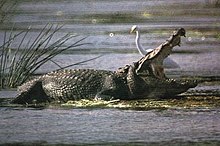Crocodylus
| Crocodylus | |
|---|---|

| |
| Mugger crocodile (C. palustris) | |
| Scientific classification | |
| Domain: | Eukaryota |
| Kingdom: | Animalia |
| Phylum: | Chordata |
| Class: | Reptilia |
| Clade: | Archosauromorpha |
| Clade: | Archosauriformes |
| Order: | Crocodilia |
| Family: | Crocodylidae |
| Subfamily: | Crocodylinae |
| Genus: | Crocodylus Laurenti, 1768 |
| Species | |
|
See text | |

| |
| Worldwide distribution of Crocodylus | |
Crocodylus is a genus in the family Crocodylidae. The scientific name was proposed by Josephus Nicolaus Laurenti in 1768.[1]
Taxonomy
Extant species
The 13-14 living species are:
| Image | Scientific name | Common name | Distribution |
|---|---|---|---|
 |
Crocodylus acutus | American crocodile | Southern Florida and the Atlantic and Pacific coasts of southern Mexico to South America as far south as Peru and Venezuela, Cuba, Jamaica, Hispaniola and Grand Cayman. |
| Crocodylus halli[2] | Hall's crocodile | southern New Guinea | |
 |
Crocodylus intermedius | Orinoco crocodile | Colombia and Venezuela |
 |
Crocodylus johnsoni | Freshwater crocodile | Northern regions of Australia |
 |
Crocodylus mindorensis | Philippine crocodile | Northern Sierra Madre Natural Park within the Luzon rainforest, San Mariano, Isabela, Dalupiri island in the Babuyan Islands, Abra (province) in Luzon and the Ligawasan Marsh, Lake Sebu in South Cotabato, Pulangi River in Bukidnon, and possibly in the Agusan Marsh Wildlife Sanctuary in Mindanao |
 |
Crocodylus moreletii | Morelet's crocodile or Mexican crocodile | Mexico, Belize and Guatemala |
 |
Crocodylus niloticus | Nile crocodile or African crocodile, (the subspecies found in Madagascar, C. n. madagascariensis, is sometimes called the black crocodile) | Israel and Syria (historically), Somalia, Ethiopia, Uganda, Kenya, Egypt, the Central African Republic, the Democratic Republic of the Congo, Equatorial Guinea, Tanzania, Rwanda, Burundi, Zambia, Zimbabwe, Gabon, Angola, South Africa, Malawi, Mozambique, Sudan, South Sudan, Botswana, and Cameroon |
 |
Crocodylus novaeguineae | New Guinea crocodile | northern New Guinea |
 |
Crocodylus palustris | Mugger crocodile, marsh crocodile, or Indian crocodile | southern Iran, southern Pakistan, southern Nepal, India, Sri Lanka |
 |
Crocodylus porosus | Saltwater crocodile or estuarine crocodile | Southeast Asia and Northern Australia |
 |
Crocodylus rhombifer | Cuban crocodile | Cuba |
 |
Crocodylus siamensis | Siamese crocodile | Indonesia (Borneo and possibly Java), Brunei, East Malaysia, Laos, Cambodia, Myanmar, Thailand and Vietnam. |
 |
Crocodylus suchus | West African crocodile or desert crocodile | Mauritania, Benin, Liberia, Nigeria, Niger, Cameroon, Chad, Central African Republic, Equatorial Guinea, Senegal, Mali, Guinea, Gambia, Burkina Faso, Ghana, Gabon, Togo, Ivory Coast and Republic of Congo |
| Crocodylus raninus (Considered to be a synonym of Crocodylus porosus; its status remains unclear.[3]) | Borneo crocodile | Borneo |
Fossils
Established species also include six extinct species:[4]
- † Crocodylus anthropophagus is an extinct crocodile from Plio-Pleistocene of Tanzania.
- † Crocodylus checchiai is an extinct crocodile from Late Miocene of Kenya.
- † Crocodylus falconensis is an extinct crocodile from Early Pliocene of Venezuela.
- † Crocodylus palaeindicus is an extinct crocodile the Miocene to the Pleistocene of southern Asia.
- † Crocodylus thorbjarnarsoni is an extinct crocodile from Plio-Pleistocene of Kenya.
Phylogeny
The cladogram below follows the topology from a 2011 analysis of mitochondrial DNA sequences by Robert W. Meredith, Evon R. Hekkala, George Amato and John Gatesy.[5]
| Crocodylus |
| ||||||
The cladogram below follows the topology from a 2012 analysis of morphological traits by Christopher A. Brochu and Glenn W. Storrs. Many extinct species of Crocodylus might represent different genera. C. suchus was not included, because its morphological codings were identical to these of C. niloticus. However, the authors suggested that it could be explained by their specimen sampling, and considered the two species to be distinct.[4]
Evolution
Crocodylus species originated from an ancestor in the Indo-Pacific region between 9 million years ago and 16 million years ago.[6] They radiated into Africa between 8 million years ago and 12 million years ago. This was followed about 6 million years ago by a trans-Atlantic migration to the Americas.[7]
References
- ^ Laurenti, J. N. (1768). "XV. Crocodylus". Specimen Medicum, Exhibens Synopsin Reptilium Emendatam cum Experimentis circa Venena [Medical Treatise, Exhibiting an Emended Synopsis of Reptiles, with Experiments Concerning Venoms and Antidotes for Austrian Reptiles]. Viennae: Joan. Thomae. pp. 53–55.
{{cite book}}: External link in|chapterurl=|chapterurl=ignored (|chapter-url=suggested) (help) - ^ Murray, Christopher M.; Russo, Peter; Zorrilla, Alexander; McMahan, Caleb D. (2019). "Divergent Morphology among Populations of the New Guinea Crocodile, Crocodylus novaeguineae (Schmidt, 1928) Diagnosis of An Independent Lineage and Description of A New Species". Copeia. 107 (3): 517–523. doi:10.1643/CG-19-240.
- ^ http://reptile-database.reptarium.cz/species?genus=Crocodylus&species=raninus
- ^ a b Brochu, C. A.; Storrs, G. W. (2012). "A giant crocodile from the Plio-Pleistocene of Kenya, the phylogenetic relationships of Neogene African crocodylines, and the antiquity of Crocodylus in Africa". Journal of Vertebrate Paleontology. 32 (3): 587. doi:10.1080/02724634.2012.652324.
- ^ "A phylogenetic hypothesis for Crocodylus (Crocodylia) based on mitochondrial DNA: Evidence for a trans-Atlantic voyage from Africa to the New World". Molecular Phylogenetics and Evolution. 60: 183–191. 2011. doi:10.1016/j.ympev.2011.03.026. PMID 21459152.
{{cite journal}}: Unknown parameter|authors=ignored (help) - ^ Srikulnath, K; Thapana, W; Muangmai, N (2015). "Role of chromosome changes in Crocodylus evolution and diversity". Genomics Inform. 13 (4): 102–111. doi:10.5808/GI.2015.13.4.102. PMC 4742319. PMID 26865840.
- ^ Wu, X.-B.; Zhang, B.-W.; Deng, Y.-P.; Ouyang, J.-H.; Jiang, X.-Y.; Lee, P.-S.; Yan, P.; Zhang, H.-B.; Miao, J.-S.; Pan, T. (2020). "Near-complete phylogeny of extant Crocodylia (Reptilia) using mitogenome-based data". Zoological Journal of the Linnean Society. doi:10.1093/zoolinnean/zlaa074.
